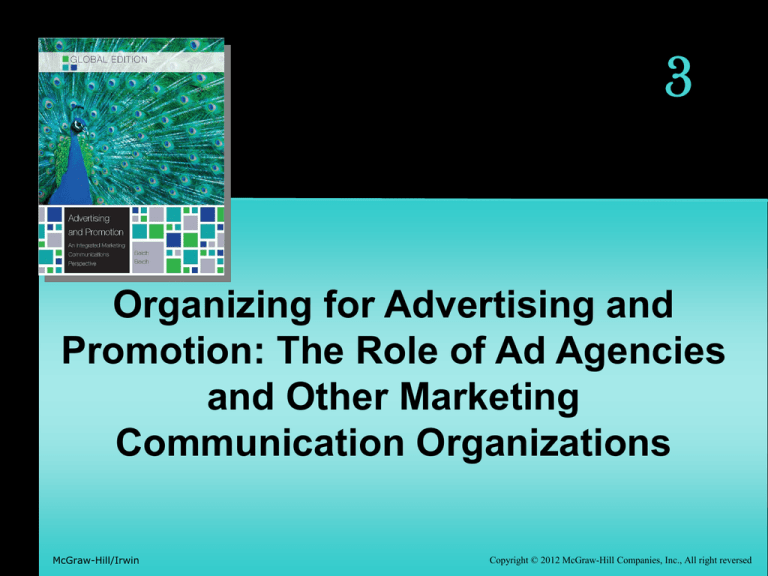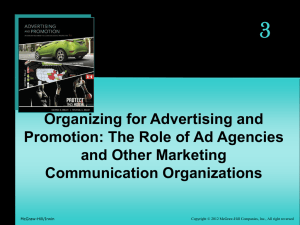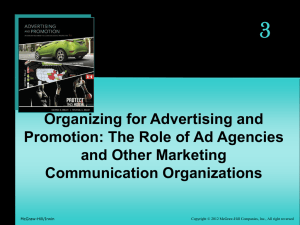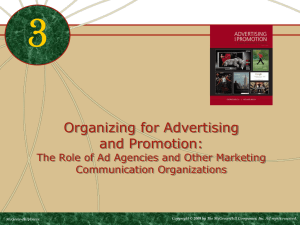Direct-Marketing Agency Services
advertisement

3 Organizing for Advertising and Promotion: The Role of Ad Agencies and Other Marketing Communication Organizations McGraw-Hill/Irwin Copyright © 2012 McGraw-Hill Companies, Inc., All right reversed Red Bull • Successful strategies • Advertising for awareness • Experiential marketing • Event sponsorship • Participation marketing • Target marketing 3-2 Participants in the IMC Process 3-3 Organizing for Advertising & Promotions • The way a company (the client) organizes depends on • Its size • The number of products it markets • The role of advertising and promotion in the marketing mix • The budget • Its marketing organization structure 3-4 Advertising Dept. Under a Centralized System President Production Finance Marketing research Marketing Advertising Research and development Sales Human resources Product planning 3-5 Pros & Cons of a Centralized System Pros Better communications Fewer personnel Cons Hard to understand the overall marketing strategy Longer response time Staff continuity More top management involvement Impractical for multiple brands, products, divisions 3-6 Decentralized Advertising System Corporate Production Finance Sales Marketing Product Management Brand Manager Ad agency Brand Manager Ad agency R&D Human Resources Marketing services Advertising Dept Marketing Research Sales promotion Package design Merchandising 3-7 Pros & Cons of Decentralization Pros Cons Concentrated managerial attention Ineffective decision making Rapid problem and opportunity response Internal conflicts Increased flexibility Misallocation of funds Lack of authority Internal focus 3-8 Test Your Knowledge Companies choose to use an in-house agency for all of the following reasons except: A) More closely tie the marketing function to top management B) Reduce advertising and promotions costs C) In-house agencies are more stable D) Tighter control over agency processes E) To diversify the brand image 3-9 Pros & Cons of In-house Agencies Pros Cons Cost savings Less experience More control Less objectivity Increased coordination Less flexibility Stability Less access to top creative talent Access to top management 3-10 Under Armour Uses an In-House Agency 3-11 The Ad Agency’s Role • Reasons for using an ad agency • Highly skilled specialists • Specialization in a particular industry • Objective viewpoint of the market • Broad range of experience 3-12 Full-Service Agencies Full range of marketing communication and promotion services Nonadvertising services Planning advertising Performing research Creating advertising Selecting media Producing advertising Strategic market planning Interactive capabilities Sales promotions Package design Direct marketing Public relations and publicity 3-13 Full-Service Agency Organization Chart 3-14 Agency Services Account Services Marketing Services Creative Services The link between agency and client Research department Creation, execution of ads Accounting Copywriter artists, other specialists Human resources Managed by the account executive May include account planners Media dept. obtains media space, time Mgmt & Finance Finance New business generation 3-15 Creative Boutiques Creative Boutiques Provide only creative services May subcontract from full-service agencies Strength is turning out creative work quickly 3-16 Media Buying Media Specialist Companies Specialize in buying media, especially broadcast time Agencies and clients develop media strategy Media buying organizations implement strategies, and buy time and space 3-17 Test Your Knowledge Which of the following statements about changes in the way advertising agencies are being compensated is true? A) Most clients do not pay full commissions to agencies because they prefer fee- or incentive-based systems. B) For both the client and the agency, the traditional commission system is superior to negotiated commissions. C) Most clients want their agencies to be in total charge of the integrated marketing communications process, so they prefer to compensate them based on media commissions. D) Statements A, B, and C are all true. 3-18 Agency Compensation Methods Commissions from media Fee, cost, and incentive-based systems Percentage charges 3-19 Evaluating Agencies Financial Audit Qualitative Audit Verify costs, expenses Planning Personnel hours billed Program development Payments to media Implementation Payments to suppliers Results achieved 3-20 Gaining and Losing Clients • Long-term agency relationships • GE/BBDO Worldwide… 80 years • Marlboro/Leo Burnett… 56 years • McDonald’s/DDB Worldwide… 43 years • Kellog’s/Leo Burnett… 68 years • Loyalty to a single agency is becoming less common 3-21 Why Agencies Lose Clients Poor performance/service Conflicts of interest Poor communication Strategy change Unrealistic client demands Declining sales Personality conflicts Compensation conflict Personnel changes Policy changes Client/ agency size change Marketing/strategy conflict Lack of integrated marketing capabilities 3-22 How Agencies Gain Clients Referrals Presentations Solicitations Public Relations Image, Reputation 3-23 Direct Marketing Agency Activities Direct-Marketing Agency Services Database management Media services Direct mail Creative capabilities Research Production 3-24 Direct Marketing Agency Structure • Departments in a typical directmarketing agency • Account management • Creative • Media • Database development/management 3-25 Sales Promotion Agencies Promotional planning Creative research Tie-in coordination Fulfillment Premium design and manufacturing Catalog production Contest/sweepstakes management 3-26 Don Jagoda Associates 3-27 Functions Performed by Public Relations Firms Strategy development Public affairs Special events Generating publicity News releases, communication Managing crisis Research Coordination w/promotional areas Lobbying 3-28 Functions Performed by Interactive Agencies Interactive Media Creation Websites Banner ads Search engine optimization Mobile marketing Social media campaigns Digital media 3-29 Campaigns Utilizing Social Media 3-30 Collateral Services • Typical collateral services • Marketing research • Package design • Consultants • Photographers • Printers • Video production • Event marketing 3-31 Pros and Cons of Integrated Services Pros Cons Greater synergy Budget politics Convenience Poor communication Single image for product or service No synergy 3-32 Test Your Knowledge Marketing executives say the biggest obstacle to implementing IMC is: A) Lack of management support B) Insufficient budgets C) Lack of people with the right perspective and skills D) Inexperienced ad agencies 3-33 Responsibility for IMC: Agency vs. Client • Key Obstacles • Lack of people with a broad perspective and the skills to make it work • Internal turf battles • Agency egos • Fear of budget reductions • Ensuring consistent execution • Measuring success • Compensation 3-34







